Abstract
A young man suffering from recurrent Neisseria infections was shown to lack detectable serum complement factor D hemolytic activity. Addition to the patient's serum of purified factor D to a final concentration of 1 microgram/ml resulted in full restoration of the activity of the alternative pathway. Using an enzyme-linked immunosorbent assay, it was shown that the patient's serum did not contain measurable amounts of factor D antigen either. The sister, the father, as well as the parents of the mother had factor D levels within the normal range, and the factor D level of the mother was decreased. The capacity of the patient's serum, at concentrations up to 5%, to promote phagocytosis of Escherichia coli by normal human granulocytes was low when compared to normal serum. Substitution of the patient's serum with purified factor D resulted in a full restoration of opsonic activity. This study describes the first complete deficiency of factor D, and demonstrates its possible relation to recurrent Neisseria infections.
Full text
PDF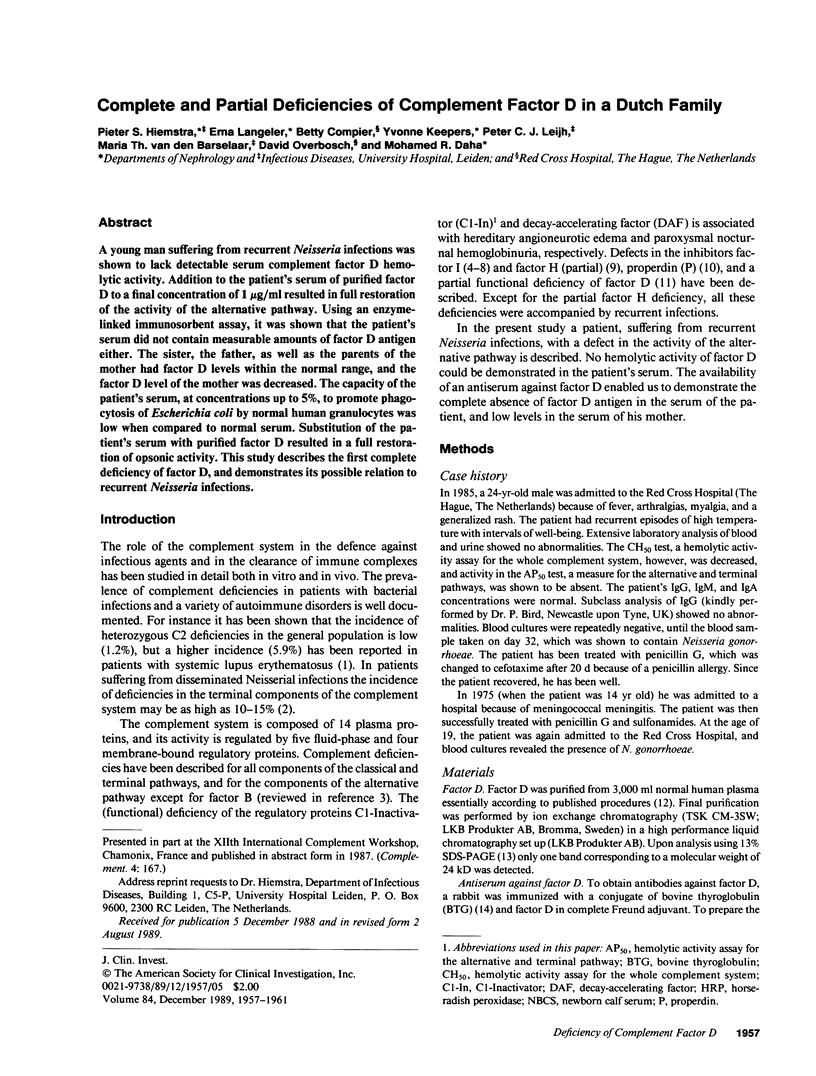
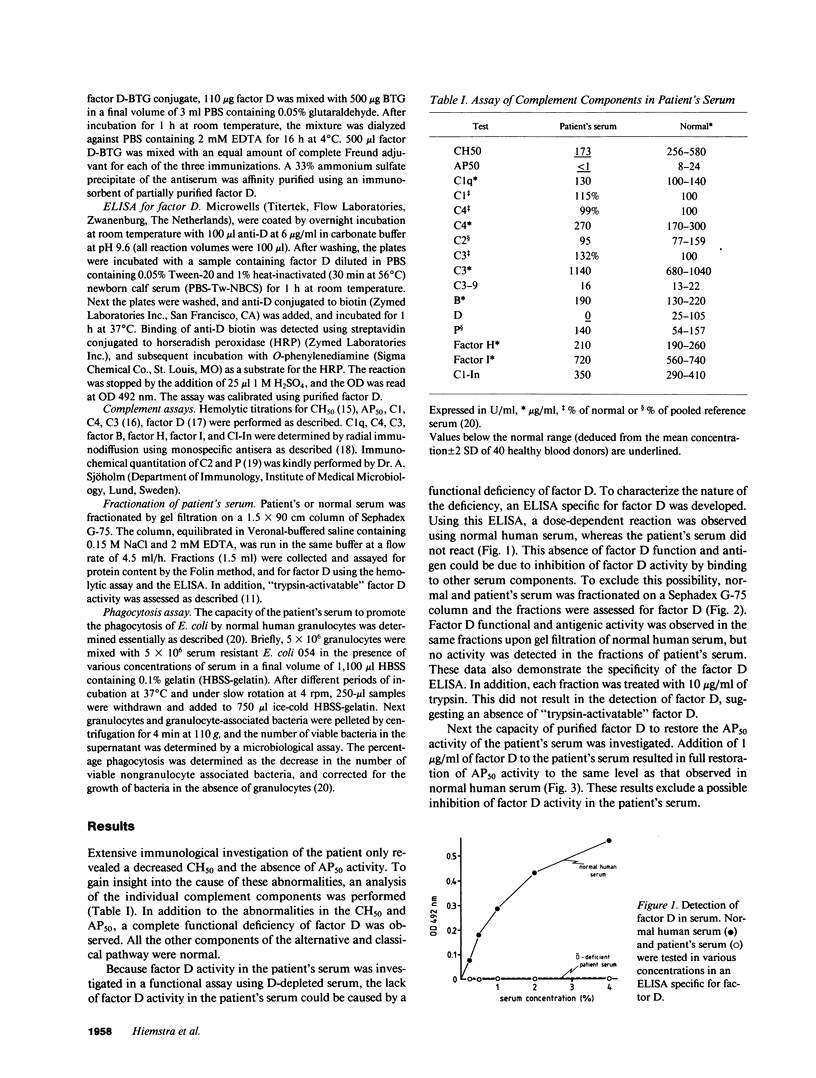
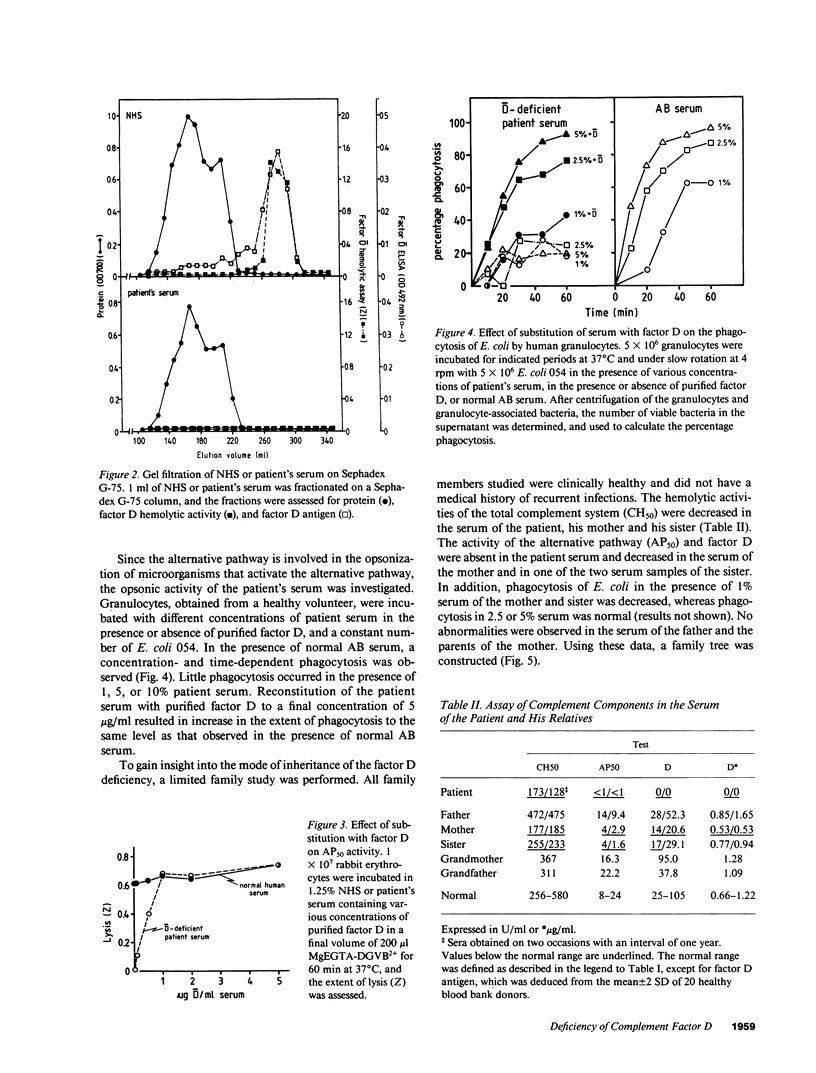
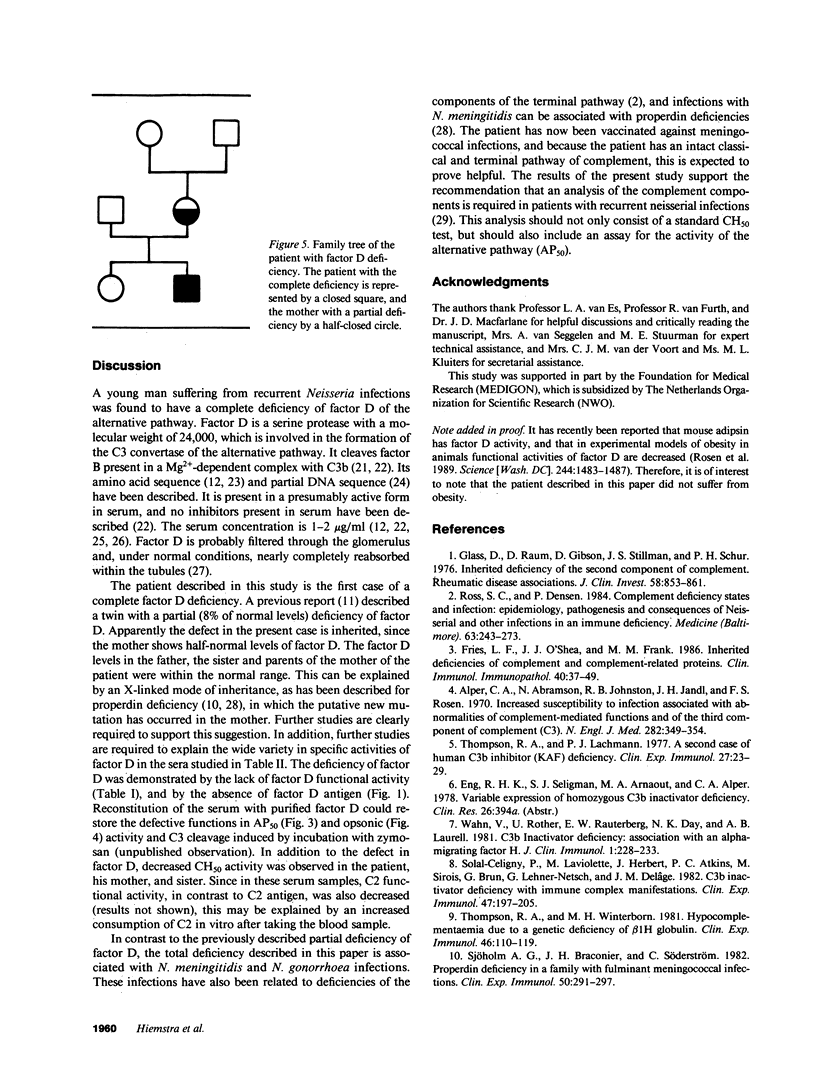
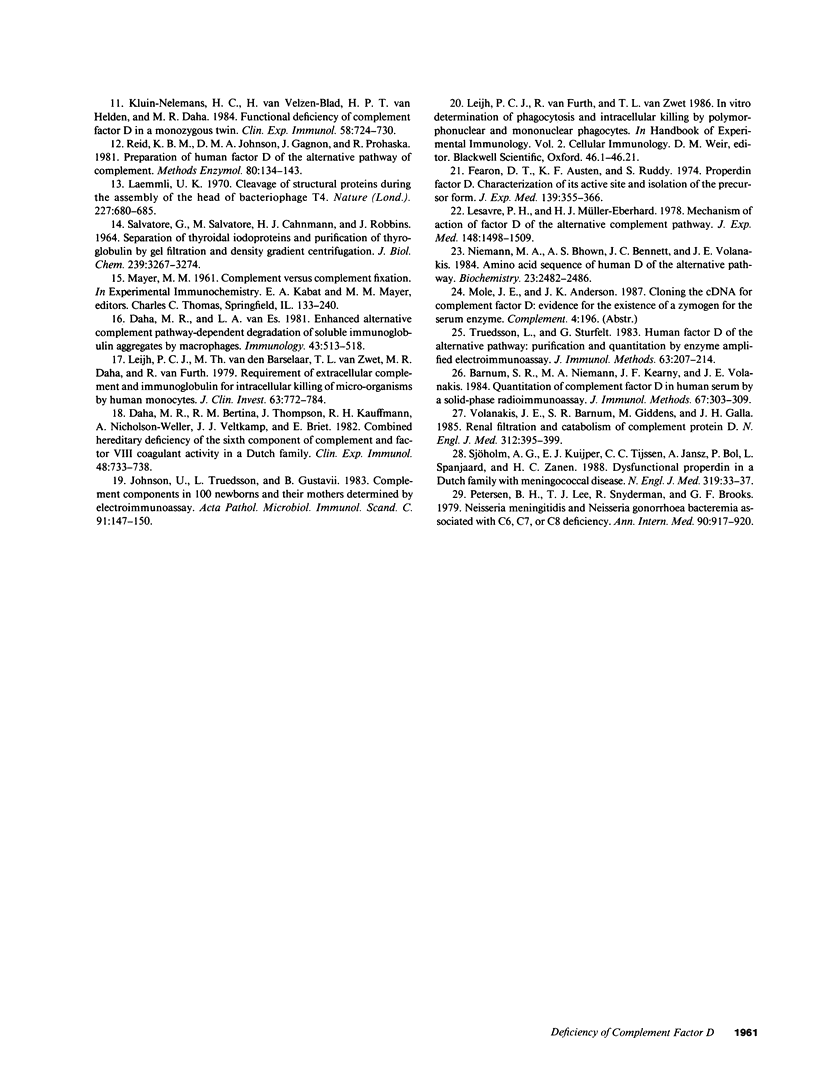
Selected References
These references are in PubMed. This may not be the complete list of references from this article.
- Alper C. A., Abramson N., Johnston R. B., Jr, Jandl J. H., Rosen F. S. Increased susceptibility to infection associated with abnormalities of complement-mediated functions and of the third component of complement (C3). N Engl J Med. 1970 Feb 12;282(7):350–354. doi: 10.1056/nejm197002122820701. [DOI] [PubMed] [Google Scholar]
- Barnum S. R., Niemann M. A., Kearney J. F., Volanakis J. E. Quantitation of complement factor D in human serum by a solid-phase radioimmunoassay. J Immunol Methods. 1984 Mar 16;67(2):303–309. doi: 10.1016/0022-1759(84)90470-8. [DOI] [PubMed] [Google Scholar]
- Daha M. R., Bertina R. M., Thompson J., Kauffmann R. H., Nicholson-Weller A., Veltkamp J. J., Briët E. Combined hereditary deficiency of the sixth component of complement and factor VIII coagulant activity in a Dutch family. Clin Exp Immunol. 1982 Jun;48(3):733–738. [PMC free article] [PubMed] [Google Scholar]
- Daha M. R., Van Es L. A. Enhanced alternative complement pathway-dependent degradation of soluble immunoglobulin aggregates by macrophages. Immunology. 1981 Jul;43(3):513–518. [PMC free article] [PubMed] [Google Scholar]
- Fearon D. T., Austen K. F., Ruddy S. Properdin factor D: characterization of its active site and isolation of the precursor form. J Exp Med. 1974 Feb 1;139(2):355–366. doi: 10.1084/jem.139.2.355. [DOI] [PMC free article] [PubMed] [Google Scholar]
- Fries L. F., O'Shea J. J., Frank M. M. Inherited deficiencies of complement and complement-related proteins. Clin Immunol Immunopathol. 1986 Jul;40(1):37–49. doi: 10.1016/0090-1229(86)90067-x. [DOI] [PubMed] [Google Scholar]
- Glass D., Raum D., Gibson D., Stillman J. S., Schur P. H. Inherited deficiency of the second component of complement. Rheumatic disease associations. J Clin Invest. 1976 Oct;58(4):853–861. doi: 10.1172/JCI108538. [DOI] [PMC free article] [PubMed] [Google Scholar]
- Johnson U., Truedsson L., Gustavii B. Complement components in 100 newborns and their mothers determined by electroimmunoassay. Acta Pathol Microbiol Immunol Scand C. 1983 Apr;91(2):147–150. [PubMed] [Google Scholar]
- Kluin-Nelemans H. C., van Velzen-Blad H., van Helden H. P., Daha M. R. Functional deficiency of complement factor D in a monozygous twin. Clin Exp Immunol. 1984 Dec;58(3):724–730. [PMC free article] [PubMed] [Google Scholar]
- Laemmli U. K. Cleavage of structural proteins during the assembly of the head of bacteriophage T4. Nature. 1970 Aug 15;227(5259):680–685. doi: 10.1038/227680a0. [DOI] [PubMed] [Google Scholar]
- Leijh P. C., van den Barselaar M. T., van Zwet T. L., Daha M. R., van Furth R. Requirement of extracellular complement and immunoglobulin for intracellular killing of micro-organisms by human monocytes. J Clin Invest. 1979 Apr;63(4):772–784. doi: 10.1172/JCI109362. [DOI] [PMC free article] [PubMed] [Google Scholar]
- Lesavre P. H., Müller-Eberhard H. J. Mechanism of action of factor D of the alternative complement pathway. J Exp Med. 1978 Dec 1;148(6):1498–1509. doi: 10.1084/jem.148.6.1498. [DOI] [PMC free article] [PubMed] [Google Scholar]
- Niemann M. A., Bhown A. S., Bennett J. C., Volanakis J. E. Amino acid sequence of human D of the alternative complement pathway. Biochemistry. 1984 May 22;23(11):2482–2486. doi: 10.1021/bi00306a025. [DOI] [PubMed] [Google Scholar]
- Petersen B. H., Lee T. J., Snyderman R., Brooks G. F. Neisseria meningitidis and Neisseria gonorrhoeae bacteremia associated with C6, C7, or C8 deficiency. Ann Intern Med. 1979 Jun;90(6):917–920. doi: 10.7326/0003-4819-90-6-917. [DOI] [PubMed] [Google Scholar]
- Reid K. B., Johnson D. M., Gagnon J., Phohaska R. Preparation of human factor D of the alternative pathway of complement. Methods Enzymol. 1981;80(Pt 100):134–143. doi: 10.1016/s0076-6879(81)80013-4. [DOI] [PubMed] [Google Scholar]
- Ross S. C., Densen P. Complement deficiency states and infection: epidemiology, pathogenesis and consequences of neisserial and other infections in an immune deficiency. Medicine (Baltimore) 1984 Sep;63(5):243–273. [PubMed] [Google Scholar]
- SALVATORE G., SALVATORE M., CAHNMANN H. J., ROBBINS J. SEPARATION OF THYROIDAL IODOPROTEINS AND PURIFICATION OF THYROGLOBULIN BY GEL FILTRATION AND DENSITY GRADIENT CENTRIFUGATION. J Biol Chem. 1964 Oct;239:3267–3274. [PubMed] [Google Scholar]
- Sjöholm A. G., Braconier J. H., Söderström C. Properdin deficiency in a family with fulminant meningococcal infections. Clin Exp Immunol. 1982 Nov;50(2):291–297. [PMC free article] [PubMed] [Google Scholar]
- Sjöholm A. G., Kuijper E. J., Tijssen C. C., Jansz A., Bol P., Spanjaard L., Zanen H. C. Dysfunctional properdin in a Dutch family with meningococcal disease. N Engl J Med. 1988 Jul 7;319(1):33–37. doi: 10.1056/NEJM198807073190106. [DOI] [PubMed] [Google Scholar]
- Solal-Celigny P., Laviolette M., Hebert J., Atkins P. C., Sirois M., Brun G., Lehner-Netsch G., Delâge J. M. C3b inactivator deficiency with immune complex manifestations. Clin Exp Immunol. 1982 Jan;47(1):197–205. [PMC free article] [PubMed] [Google Scholar]
- Thompson R. A., Lachmann P. J. A second case of human C3b inhibitor (KAF) deficiency. Clin Exp Immunol. 1977 Jan;27(1):23–29. [PMC free article] [PubMed] [Google Scholar]
- Thompson R. A., Winterborn M. H. Hypocomplementaemia due to a genetic deficiency of beta 1H globulin. Clin Exp Immunol. 1981 Oct;46(1):110–119. [PMC free article] [PubMed] [Google Scholar]
- Truedsson L., Sturfelt G. Human factor D of the alternative pathway: purification and quantitation by enzyme amplified electroimmunoassay. J Immunol Methods. 1983 Oct 14;63(2):207–214. doi: 10.1016/0022-1759(83)90424-6. [DOI] [PubMed] [Google Scholar]
- Volanakis J. E., Barnum S. R., Giddens M., Galla J. H. Renal filtration and catabolism of complement protein D. N Engl J Med. 1985 Feb 14;312(7):395–399. doi: 10.1056/NEJM198502143120702. [DOI] [PubMed] [Google Scholar]


